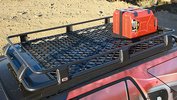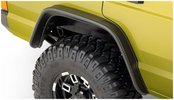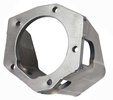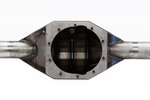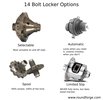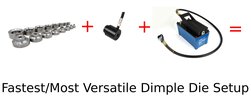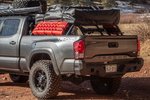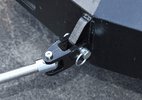4.10, 4.56, 4.88, 5.29 - What gears should you get for your Toyota?
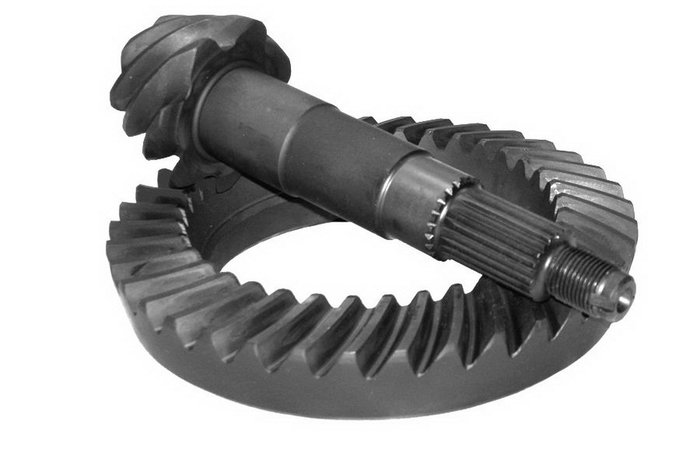
Choosing gears for your Toyota mini truck,
Tacoma, or 4Runner is a dilemma.
So many ratios, so many brands, different diffs, pinion splines, and more!
Gears, setup kits, and installation
are expensive, so this is a mod you usually want to do only once.
We'll try to clear up some of the confusion in choosing the right gears for your Toy, and a few parts you might need to make your gears install go smoothly. We'll mostly talk about Toyota minis and 4Runners in this article with a sprinkling of other models.
- Toyota 4 cyl Gears, Toyota V6/Turbo Gears, and Tacoma/T100/Tundra Gears
- Trusty Toyota Ring and Pinion Gear Brands
- Context is everything: When you choose gears, your usage, rig specs, and your driving style all matter.
- Toyota Axle Gearing Rules of Thumb
- Quick Gear Tips and Nomenclature
- Factors that affect gear ratio
- Your desired road engine RPM and road performance
- Your desired crawl ratio
- Do you live in a hilly or mountainous area?
- Gear set strength
- Weight of your truck
- Are you towing a lot of large, heavy loads?
- Brand of tire and actual height of your tires
- Do you have a doubler or 4.7s in your transfer case?
- What engine do you have? Is it modded? Is it tired?
- So let's think about power and gears in a practical situation:
- Changing your ring and pinions? Well, while you're in there....
- Can You Install Gears Yourself?
- Cheap 4.88 Gears from Toyota
- Cheap 4.88 Gears: 4.88s straight from Toyota
- 4.11 Toyota 8" V6/Turbo with flange
- 4.56 Toyota 8" V6/Turbo with flange
- 4.88 Toyota 8" V6/Turbo with flange
- 5.29 Toyota 8" V6/Turbo with flange
- 5.71 Toyota 8" V6/Turbo with flange
- W56 1st gear: 3.954
- W56 5th gear: 0.850
- RF1A Low: 2.28
- Current ire size
- Current gear ratio
- Current transmission's 5th gear ratio (or whatever the top is)
- Your typical highway cruising speed
- New tire size
- Transmission's 5th gear ratio (or whatever the top is)
- Your typical highway cruising speed
- The calculated rpm from above
- You will need trailer brakes. Increasing acceleration without increasing braking performance makes you have an unbalanced, unsafe driving experience.
- You're probably pulling too much weight.
- You can try out your 5VZFE, stock gears, and 37s and see if you like it. Maybe you have a 4.7 t-case gears and you don't drive on the road that much and this works out okay for you.
- Maybe you find a cheap axle set on craigslist with lockers and 4.56s already set up. It's a screaming deal, and you have a doubler setup for the trail.
- Maybe you cruise some Pick-and-Pulls and dig up some cheap factory 4.88 thirds. While you might appreciate the extra pickup from the 5.29s, you're perfectly content saving some coin that you can put towards lockers.
Toyota 4 cyl Gears, Toyota V6/Turbo Gears, and Tacoma/T100/Tundra Gears
4 cylinder and V6 gears are the most common gears out there for older Toyotas.
4 cylinder Toyota gears (27 spline) are found in all pre-1995 Toyota pickups and 4Runners in the front and rear.
Toyota V6 and turbo gears (27 spline) are found in all 1986-1995 4 cylinder turbo and V6 Toyota pickups and 4Runners in the rear.
Note: 4 cylinder turbos are rare and only came in a couple of years.
1996 and up 4Runners and rear electric locking diffs use the V6/Turbo gears with a 30 spline pinion.
1993-1997 Landcruiser
FZJ-80s use a high-pinion electric locking diff with reverse-cut gears. Swaps right in to an older 8" housing.
Tacomas, Tundras, and T100s use an 8" ring and pinion with a 30 spline pinion in open differentials (non-electric locking).
You must read this about pinion splines!
Just to make things a little harder, some aftermarket gear manufacturers make Toyota ring and pinions with 29 spline pinions!
The 29 spline pinion never occurred in the factory until the early 2000s. It is a little stronger than a 27 spline pinion.
29 spline pinions are getting more common now, so you may want to make the switch if you don't know what you have.
It's easy to buy a triple-drilled 27 spline pinion flange or a triple-drilled 29 spline pinion flange. You can also use a 2004 and up pinion flange out of a 4Runner as long as it fits your driveshaft since they had 29 splines from the factory.
A quick note on pinion splines on Toyota mini trucks and 4Runners
Most Toyota trucks and 4Runners 8" diffs have 27 spline pinions. EXCEPT for the 1996-2003 4Runners. They use a 30 spline pinion. There are also 29 spline pinions in 2004 and up 4Runners and maybe some other 8" diffs.
So, we'd suggest you use either a 27 spline or 29 spline pinion. The 29 spline is probably better - it's stronger and you can get a triple-drilled flange for it.
That said, 27 spline flanges are very common since they used to be the only option. We suspect, however, that 29 spline pinions are going to be what manufacturers make in the future and that it'll get harder to find 27 spline pinion Toyota gearsets.
A quick note on Toyota Tacoma, Tundra, and T100 diffs
The Tacoma, Tundra, and T100 differentials are stronger than the earlier 8" Toyota diffs. This is due to larger carrier bearings and a larger diameter pinion shaft. However, the ring and pinion won't fit into an earlier diff and the differential itself won't fit into an earlier axle housing.
Trusty Toyota Ring and Pinion Gear Brands
Yukon Gears are higher end Toyota ring and pinions made of 8620 dual heat-treated
alloy. If you want long-lasting gears, use 8620 and do a proper
break-in.
If you need the next level in strength, you can also get them cryo-treated.
Similarly to Yukons, Sierra Gears are also a high-end 8620 Toyota ring and pinion that have been around for a while.
We
suspect that Yukon and Sierra Gear come out of the same factory as
they're both heat-treated 8620. An interesting fact about gears is that many ring and pinions all come
out of the same few factories and are rebranded in the retail market. Very early on Yukons were not
necessarily a great gear - they were often just a rebranded gearset from
another manufacturer.
This changed sometime in maybe the mid-late 2000s and now they're pretty much the gold standard gears for Toyotas. Between the 8620 alloy and the heat treat they'll last longer and be stronger than "normal" gears with a
proper break-in.
And frankly, any gearset you can find that is made out of 8620 and heat treated will probably be just fine.
In any case, below we list out some Yukon ring and pinions for the most common Toyota diffs.
Yukon Gear Toyota Ring and Pinion Gears
Below we've linked to the most common Toyota ring and pinions. We've included ring and pinions plus ring and pinions with a "conversion kit" that adds a pinion nut, pinion seal, and 29 spline flange.
This can be cheaper than buying the flange separate depending on the set. Yukon flanges are multipattern so that you can fit different driveshaft patterns.
4 Cylinder Toyota ring and pinion gears w/29 spline pinion (gears only)
4 Cylinder Toyota ring and pinion gears w/29 spline pinion (gears plus pinion nut, seal, and flange)
V6/Turbo Toyota ring and pinion gears w/29 spline pinion (gears only)
V6/Turbo Toyota ring and pinion gears w/29 spline pinion (gears plus pinion nut, seal, and flange)
Context is everything: When you choose gears, your usage, rig specs, and your driving style all matter.
Let's start off by saying that there is a wide range of "contentment" when it come to gear ratio.
Everybody has preferences and we all use our trucks a little differently. If you "drive it like you stole it", you will likely prefer taller gears than the fuel-conserving miser that greedily stares at his dash-mounted vacuum gauge to ensure he's not sucking down too much petrol at every green light (Roundforge is a judgment-free zone).
You can easily see that people have huge differences in opinion on what gears to run. They'll often say things like "You unquestionably need 5.29s with 35s" or "I daily drove my Toy with 4.10s and 35s for years without a problem."
We'll submit that maybe it's because context is everything. The guy daily driving in the Colorado Rockies is different from the daily driver in Florida which is different than the weekend rockcrawler in Pennsylvania which is different than the competition rig in New Mexico.
While there are definitely well-followed "recipes" to setting up our Toyotas, your truck probably still has some qualities that differentiate it from other trucks - you've got a header, you have high miles on the engine, you have a 1st Gen 4Runner with 1000 lbs of armor and gear. Plus you've got personal preferences in how your truck drives - you might not mind shifting a little more, or maybe you want to be pulling strongly on every hill in 5th gear.
The takeaway is that you should keep your own situation and preferences in mind when you're choosing gears and be cautious when anybody uses absolute terms unless you have virtually the same truck and drive it virtually the same way. You don't need to overthink your gearing, but be aware that your setup doesn't have to match someone else's just because they say so.
Toyota Axle Gearing Rules of Thumb
Below is a chart relating axle gearing, tire size, and RPM, plus the difference in RPM from "stock". Our stock setup (bolded) is 28" tall tires and 4.10 gears. All other things being equal, the green zone will give you performance similar to the "stock" setup. In the yellow zones you'll notice some changes. In the red zones, there are definitely consequences to poorly matched tires and gears. Of course, our breaks between zones are somewhat arbitrary - going from a 10% from stock difference in RPM to 11% difference probably won't be that noticeable.
It's really important that you understand that people comfortably run all sorts of gear and tire combos - they may have a rebuilt 22RE with an aggressive cam, a worn-out 22R in a heavily built pickup, or a small block Chevy pushing 4.10s and 35s. This chart is simply saying that if you currently have 28s and 4.10s, you'll get similar road performance with any combo in the green zone.
The last thing we want to point out is that to match your current performance, you'd want to run your own numbers with your current stock setup - after all, you may have gotten 4.30s and 31s from the factory. We're mostly illustrating that there are a fairly wide range of tire and gear combos that can get you where you need to be. In the future, we may build a calculator that has similar functionality to the below chart.
| Tires (true size [1]) | Rear axle ratio | RPM @ 65mph [2] | % difference from stock |
|---|---|---|---|
| 38 | 4.10 | 2005 | -26% |
| 37 | 4.10 | 2059 | -24% |
| 38 | 4.30 | 2103 | -23% |
| 36 | 4.10 | 2116 | -22% |
| 37 | 4.30 | 2159 | -21% |
| 35 | 4.10 | 2177 | -20% |
| 36 | 4.30 | 2219 | -18% |
| 38 | 4.56 | 2230 | -18% |
| 34 | 4.10 | 2241 | -18% |
| 35 | 4.30 | 2283 | -16% |
| 37 | 4.56 | 2290 | -16% |
| 33 | 4.10 | 2309 | -15% |
| 34 | 4.30 | 2350 | -14% |
| 36 | 4.56 | 2354 | -14% |
| 32 | 4.10 | 2381 | -13% |
| 38 | 4.88 | 2386 | -12% |
| 35 | 4.56 | 2421 | -11% |
| 33 | 4.30 | 2421 | -11% |
| 37 | 4.88 | 2451 | -10% |
| 31 | 4.10 | 2457 | -10% |
| 34 | 4.56 | 2492 | -8% |
| 32 | 4.30 | 2497 | -8% |
| 36 | 4.88 | 2519 | -7% |
| 30 | 4.10 | 2539 | -7% |
| 33 | 4.56 | 2568 | -6% |
| 31 | 4.30 | 2577 | -5% |
| 38 | 5.29 | 2587 | -5% |
| 35 | 4.88 | 2591 | -5% |
| 32 | 4.56 | 2648 | -3% |
| 37 | 5.29 | 2657 | -2% |
| 30 | 4.30 | 2663 | -2% |
| 34 | 4.88 | 2667 | -2% |
| 28" | 4.10 | 2721 | 0% |
| 36 | 5.29 | 2730 | 0% |
| 31 | 4.56 | 2733 | 0% |
| 33 | 4.88 | 2748 | 1% |
| 38 | 5.71 | 2792 | 3% |
| 35 | 5.29 | 2808 | 3% |
| 30 | 4.56 | 2824 | 4% |
| 32 | 4.88 | 2834 | 4% |
| 37 | 5.71 | 2867 | 5% |
| 34 | 5.29 | 2891 | 6% |
| 31 | 4.88 | 2925 | 7% |
| 36 | 5.71 | 2947 | 8% |
| 33 | 5.29 | 2979 | 9% |
| 30 | 4.88 | 3022 | 11% |
| 35 | 5.71 | 3031 | 11% |
| 32 | 5.29 | 3072 | 13% |
| 34 | 5.71 | 3120 | 15% |
| 31 | 5.29 | 3171 | 17% |
| 33 | 5.71 | 3215 | 18% |
| 30 | 5.29 | 3276 | 20% |
| 32 | 5.71 | 3316 | 22% |
| 31 | 5.71 | 3422 | 26% |
| 30 | 5.71 | 3537 | 30% |
Quick Gear Tips and Nomenclature
"High" Gears
"High" gears are numerically low. 4.10s are on the "high" side for modified Toys. High gears with big tires give you a lower engine RPM on the highway, but may be too high to rockcrawl in a slow, controlled manner. 1st gear takeoff might involve painful lugging of the engine (similar to starting from a stop in second instead of 1st). Gas mileage will be better with high gears since you can move at faster speeds with fewer RPMs (this is not all there is to good gas mileage, of course).
"Low" Gears
"Low" gears are numerically high. 5.71s are on the "low" side for modified Toys. You'd get super fast and torquey takeoffs from a dead stop, but you'd be limited to a pretty low top speed since the engine would be running at such a high RPM. This will make it hard to do long highway distances at a reasonable speed with a reasonable engine RPM.
As an example, 4.10s are "higher" than 5.29s and are more suited for smaller tires. Thus, we'll often say that a stock gear ratio is too "high" for bigger tires and that one needs to install "lower" gears. Adding big tires has the same effect as adding higher gears to your truck. A taller tire has a larger circumference and travels further with each complete revolution.
| Tire height | Tire circumference [1] | Distance covered in one tire revolution |
|---|---|---|
| 28" | 89" | 89" |
| 35" | 110" | 110" |
| 40" | 126" | 126" |
[1] Tire circumference is calculated with the formula:
circumference = pi x diameter OR circumference = 3.14 x diameterSince big tires or high gears allow you to cover more distance with each revolution of the engine, engine RPM is lower for a given speed. The exact opposite happens with using smaller tires or lower gears.
In our chart below, we've got some gearing extremes, along with the RPMs you might get from a stock 1st Gen 4Runner. For the sake of comparison, most of us probably idle around 600-800 RPM.
Please note that normal people would never run these gears. For instance, a likely combo on the trail could be cryo-treated 5.71s and 42" or 44" tires. 3.73s and 44s would be insane.
| High gears, big tires: | Stock-ish: | Low gears, small tires: | |
|---|---|---|---|
| 3.73 gears, 44" tires | 4.10 gears, 28" tall tires | 5.71 gears, 28" tires | |
| 1st gear, 4x4 Low, 2 mph | 514 | 888 | 1237 |
| 1st gear, 5 mph | 564 | 976 | 1356 |
| 4th gear, 50 mph | 1425 | 2462 | 3429 |
| 5th gear, 65 mph | 1575 | 2720 | 3789 |
| 5th gear, 75 mph | 1817 | 3139 | 4372 |
For this example we assume a W56 transmission and RF1A transfer case. Ratios are:
What happens with high gears (3.73) and big tires (44")?
Looking at the high gears/big tires example, we could expect terrible trail performance. At idle, you'd be moving quite quickly. At lower RPMs, you'd likely stall and slip the clutch quite a bit since your engine would be operating so far outside it's torque curve. As for the highway - well, you'd have lots of power at high speeds. At 1800 RPM the 22RE still has plenty of power on tap, but using it would probably mean that you were severely breaking the speed limit. At 3000 RPM (comfortable for highway cruising the 22RE) you'd be traveling at 124 mph.
What happens with low gears (5.71) and small tires (28")?
The low gears, small tires is quite the opposite. You'll get tons of low speed torque and fast acceleration. Your Toy would feel extremely peppy and torquey and you'd be doing burnouts galore. You'd probably have trouble stalling the engine with the brakes in 4 Low. While this would be fun on the trail (maybe a little too slow without other gearing options), it would be miserable on the highway. At cruise speed on the highway the engine would be screaming and awfully close to the redline on a 22RE (this appears to vary from 5200-5800 rpm).
Factors that affect gear ratio
Ideally, when installing larger tires you'd install gears that put you at the same engine rpm as your original setup. You might not be able to do exactly that due to budget, future build plans, or something else. So following is a list of some things to think about when you need to upgrade your gears. Some of these things won't matter to you, some of them you can't change, and maybe some of them you'll decide to change after reading this. We know that building a 4x4 is often an exercise in deal-hunting and working within a budget. Here they are:
Your desired road engine RPM and road performance
This is a pretty big one for most people since their 4x4 is often a daily driver, second car, or at least needs to get to the trailhead. Your highway cruising RPM will be your "goal" RPM. For highway cruising, you need to know:
You plug these figures into a gearing calculator and this will tell you your engine's rpm at highway speed. Then you take your:
and you run it through a gearing calculator to give you the optimum gear ratio you should be running with those tires. This number probably won't be an actual gear ratio, so you need to pick a gear ratio close to it that will suit you.
Your desired crawl ratio
Going to be on the trail a lot? Well, for most of us the ability to move slowly in a controlled manner with lots of torque is extremely beneficial. This means having enough torque to get over obstacles at low engine RPMs without slipping the clutch. With high gears you go fast on the trail, and with low gears you go slow.
When you shift into 4-Low, you are usually at least doubling your crawl ratio (In a RF1A transfer case you go from a 1:1 gearing in high to 2.28:1 gearing in low). Lower axle gears result in a similar shift as low transfer case gears.
That said, daily drivers will want to ignore crawl ratio when choosing ring and pinion gears. For daily drivers, on-road engine RPMs are the most important. It's better to alter crawl ratio with a lower first gear, low transfer case gears, and/or a doubler since each of them only negligibly affects how your rigs performs on the road. Installing lower gears to get a better crawl will make your highway cruising suffer.
Do you live in a hilly or mountainous area?
Daily driving a 22RE in hills with too-high gears might make your truck feel gutless. You may have to downshift to 4th more frequently and this might annoy you (or maybe not). In more extreme cases, overdrive might not even be useful if it puts your top speed far from the speed limit or if the hills are simply too steep.
Similarly, if your typical stomping grounds are pretty flat, you might not mind slightly too-high gearing and a little less effective power since you'll have slightly better gas mileage. Most find that lots of hilly driving requires slightly lower gears to make hill driving tolerable.
Gear set strength
As gears get lower in ratio, so does their strength. Thus, a 4.10 ring and pinion will be stronger than a 5.29 ring and pinion. This strength issue is primarily with the pinion, which gets smaller as the ratio increases. Unfortunately, this is the opposite of what we need since most of us want big tires, low gears, and a strong pinion.
For the average Joe running 35s or (maybe) 37s and a 4 cylinder this probably isn't too important. And if you're reading this, R&P strength probably aren't too important for you...yet! Strength would be more concerning with a heavier rig on big BFG sticky tires with more horsepower and an aggressive driver. For those wheelers, there is always cryo-treating to strengthen gearsets.
Weight of your truck
Here is an experiment: Go outside and run around the block. Wave to your old lady neighbors (this is not part of the experiment, but they might bake you something). Return home, put on a 50 lb backpack, and run around the block again. The second time is harder, right? Now imagine your Toy doing the same thing. This basically happened to the 4Runner when it went from the 1st Generation to the 2nd Generation model. 1st Gen 4Runners weigh around 2800 lbs. 2nd Gen 4Runners weigh about 3800 lbs., almost 1000 lbs more than 1st Gens! Safety and functionality have consistently added weight through succeeding Toyota pickup and 4Runner generations
While there were some changes to the 4 cylinder 22RE over the years, we think it's pretty fair to say that the weight increase outpaced the 22RE's power output. It's telling that Toyota also introduced the infamous 6 cylinder 3VZE at the end of the 1st Gen 4Runner's life.
To further make our point, it you probably have or will add quite a bit of weight in aftermarket parts and fabricated upgrades. Just a winch, bumpers, and sliders will have you close to an extra 500 lbs for most Toyotas, not to mention camping or other wheeling gear that you carry. The takeaway is this: Fat trucks aren't peppy. If you have a 3rd Gen 4Runner, you'll probably be more sensitive to the effects of larger tires than a 1st Gen 4Runner, especially with a 4 cylinder.
Are you towing a lot of large, heavy loads?
This fits well with having a heavy vehicle. Lower gears will make accelerating easier. However, we think gearing with tow loads is really more of an issue for full size trucks and tow vehicles. Why? Well, you shouldn't be towing much weight with your Toy to begin with. If you're towing so much that you need to think about gearing, then:
If you expect to be towing 1000 lbs. full time (maybe you're doing a year-long expedition), then you maybe want to think about going down a step in gearing. Otherwise, don't worry about it.
Brand of tire and actual height of your tires
You think tire height is simple and that you can just plug the tire's sidewall height into an RPM calculator, right? Wrong!!! The number you need to use is the height from the ground to the centerline of your drive axle. Why?
First of all, tires are often not their sidewall height. Some tire manufacturers put dimensions on the sidewall that don't match the tire (some BFG 35s are known to measure out at 33" tall!) and mounted tires are often a little shorter than unmounted. It is important to measure so that you can plug the correct numbers into the calculator, since you want little room for error.
Secondly, when you have weight on your truck, the axle-centerline-to-tire-top measurement will be more than axle-centerline-to-ground measurement. We only care about the distance from the ground to the axle centerline because this is the radius for the effective circle that the driving motion your wheel makes by spinning.
Putting this all together, if you have a generic 35x12.5R15 MT tire, you would measure from the ground to the axle centerline. You might get something like 16.25". This is the radius of the travel path of the tire as it contacts the ground. Multiply that by 2 to get 32.5", which is the effective diameter of your tire. 32.5" is the diameter you use in RPM calculators. For something as expensive as regearing, don't wing your calculations by using the tire's sidewall dimensions.Do you have a doubler or 4.7s in your transfer case?
If you plan to go fourwheeling, lower gears will help you go slow and generate torque to get over obstacles. If you have a doubler setup or a 4.7 gearset in your transfer case, your axle gearing is a little less important for off road use since doublers and 4.7s offer so much reduction.
What engine do you have? Is it modded? Is it tired?
Engines with less horsepower and torque will feel the pain of bigger tires more than those with buckets of horsepower. Check out how horsepower and torque have changed over the years in Toyotas:
| Engine | Horsepower | Torque (ft-lb) |
|---|---|---|
| Early 22R, carbureted | 97 | 129 |
| Early 22RE | 105 | 137 |
| Late 22R | 108 | 138 |
| Late 22RE | 114 | 140 |
| 22RTE (turbo) | 135 | 173 |
| 3VZE | 150 | 180 |
| 5VZFE | 190 | 220 |
This is definitely not a complete list of Toyota engines, because we really wanted to highlight the horsepower and torque differences between different motors. The first engine on this list has slightly over half the horsepower and about 59% of the torque of the last engine. That's a huge difference!
Plus, those numbers assume a factory-fresh engine. If your engine has a lot of miles, you may have cruddy ignition, clogged/dirty injectors or carb, bad compression, or just general power-robbing wear.
We suspect that engine condition and upgrades account for a big chunk of the variety of acceptable gearing that you read about in Toy forums. There are people out there running around with a small block Chevy, 4.10s, and 37s. That doesn't make it ideal, but it's doable.
So let's think about power and gears in a practical situation:
You have an early 80s Toyota pickup with the carbed 22R engine. It weighs around 2800 lbs and you want 37s. As your engine is pumping out 97 hp, you'll almost certainly need regearing to 5.29s to be happy on the road.
But let's just say a you're a budget builder and a low-miles 4Runner with a 5VZFE/R150 combo falls into your lap. You decide to swap it in to your mini. Even with a low budget, more horsepower gives you more options:
Changing your ring and pinions? Well, while you're in there....
Ring and pinions go for around $200 per set. Labor to install per set will range from $100-$400. The low end is probably "a guy my buddy knows", the high end is "that shop I've never been to". Whoever sets up your gears should be a meticulous person and have some experience setting up gears for long hauls. You might decide to set up your gears yourself. This is not so bad and there are lots of guides on the Internet for doing it. Since you are either a) paying a bunch of money to have someone install your gears or b) spending a lot of time to learn how to set up your gears, you may want to consider some other upgrades as well.
Third member upgrade
You've either got a 4 cylinder third member or a 6 cylinder third member in your rear axle. They both fit Toyota 8" axle housings but the 6 cyl is stronger. If you have plans to bump your horsepower or you're aggressive on the trail, look for 6 cylinder thirds to put gears into. You'll need to buy corresponding 6cyl ring and pinions, which are slightly more expensive. 4 cylinder and 6 cylinder parts are mostly not interchangeable. They take different lockers and gears, so plan accordingly.
Lockers
A lunchbox locker goes for about $200, an ARB is pushing $900. A used Toy e-locker is around $400. Might this be a good time to install a locker? Yes, yes it would.
Multipattern flange
A multipattern flange is simply a pinion flange that is drilled for different driveshaft bolt patterns. This might come in handy if you'll be whipping up some spare driveshafts in your backyard or getting custom driveshafts in the future.
Is a SAS crazytalk?
It seems a little overboard to suggest a solid axle swap when you just want gears, BUT what we're really saying is this: Don't dump a ton of money in your IFS diff if you're going to a solid axle in the future. Why? None of the parts in your 7.5" IFS diff will swap into a Toyota 8" differential. If you really need lower gears in your IFS but you're planning a solid axle swap, troll Craigslist for already swapped 7.5" 5.29s or look for the stock 4.88 thirds (read below) to save some coin.
Can You Install Gears Yourself?
The short answer is yes, but read on. If you do decide to take this on yourself, plan on needing a full day to set up one diff. Pros can do it in 5-10 hours depending on the axle. In theory, this means that you can do the whole job in a weekend. If you're afraid of messing up, do the rear axle and drive it around (DO NOT ENGAGE 4WD). Listen for noises and feel for excessive heat off the diff cover. If you're in the clear, do the front. Plan on the front taking a little longer since there are a few more parts to dismantle. Tools will probably cost in the area of $200 if you aren't well-equipped already. You should be comfortable with precision measuring and mechanical work. Take a look here for some guides on installing ring and pinion gears.
Don't be afraid to take your gears to a pro!
If you need the job done right on your daily driver, don't like dealing with precision setups, or have more cash than time, go to a pro diff shop to have your gears done. People do fail at gear installs and this can ruin other axle parts if a bad install results in overheating or tooth-chipping. Gear setup is for lovers, not fighters.
Cheap 4.88 Gears from Toyota
Some Toys came with 4.88s from the factory! You can swap these into your 8" front solid axle, 8" rear axle, or 7.5" IFS. The 8" version will work with 6 cylinder lockers and LSDs. We have more info about the factory Toyota 4.88 gears here.
Last updated: September 5, 2019
